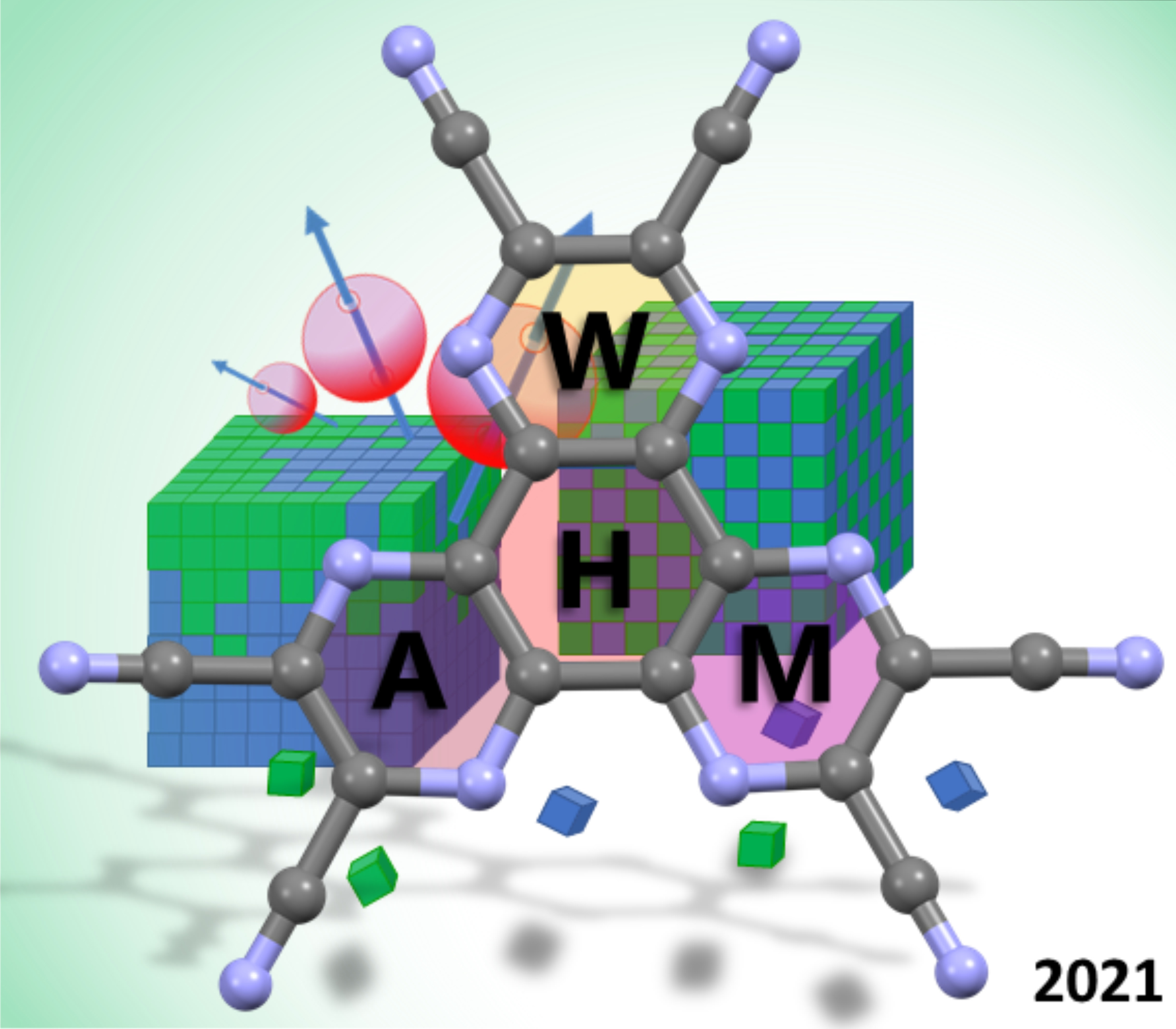Grupa Wieloskładnikowych i Hierarchicznych Architektur Molekularnych (WHAM)

Multicomponent and Hierarchical Molecular Architectures Group (WHAM)
Group leader:
Prof. dr. habil. Robert Podgajny
phone: +48 12 686 24 59
e-mail: robert.podgajny@uj.edu.pl
Members:
Katarzyna Jędrzejowska, MSc (PhD student)mgr Dorota Głosz, MSc (PhD student)
Research themes
The WHAM group deals with the construction and getting knowledge on multicomponent molecular systems, what is an extremely interesting instrument in development of strategies for obtaining new molecular architectures of functional nature based on magnetic, optical, chiral or sorption properties, including also structure-properties-function schemes tunable owing to phase transitions and reconstruction of the crystal lattice. We are interested (i) in discovering completely new architectures, obtained as a result of self-assembly processes involving selected molecules or their aggregates, as well as (ii) in deliberate construction based on already known architectures through interchanging of components dedicated to specific places or entire areas of the crystal lattice, without its significant disturbation, or at least with preservation and reproducibility of local molecular arrangement. Thus, using principles of the building block approach and molecular tectonics, and based on hierarchical nature of molecular networks, we aim at obtaintion of new materials of significantly modified electronic valence structure and physicochemical properties and / or reactivity in a controlled manner. According to the above, we prepare and examine:
- molecular solid solutions of isotropic nature, properties of which change continuously with the change of the content of essential components;
- domain-type molecular crystal composites, with various properties coexisting in different areas of a single object;
- polynuclear coordination clusters showing speciation in the nature of coordination sites and individual behavior of the relevant complex moieties;
- co-crystalline phases (co-crystals, co-crystalline salts) including simple and polynuclear coordination complexes.
- multisite anion receptors dedicated to the binding and recognition of d-block metal ion complexes as important building blocks in the construction of polynuclear complexes.
The scientific and philosophical nature of the above research themes was shaped on the basis of the previous experience of the group director and his project team, with particular emphasis on the modular synthesis of molecular connections showing:
- reversible spin and structural phase transformations (spin-crossover, electron transfer);
- chirality and non-centrosymmetry;
- magnetocaloric effect;
- structural disorder;
- new patterns of non-covalent interactions, e.g. charge transfer anion-π interactions.

Representative publications
- D. Marcinkowski, M. Kubicki, V. Patroniak, T. Muzioł, S. Chorazy, L. Shi, M. Zychowicz, A. M. Majcher-Fitas, R. Podgajny, A. Gorczyński, "Trityl-Based Lanthanide-Supramolecular Assemblies Exhibiting Slow Magnetic Relaxation", Chem. Eur. J., 2023, e202300695.
- L. Shi, J. Kobylarczyk, K. Dziedzic-Kocurek, J. J. Stanek, B. Sieklucka, R. Podgajny, "Site Selectivity for the Spin States and Spin Crossover in Undecanuclear Heterometallic Cyanido-Bridged Clusters", Inorg. Chem., 2023, 62, 7032-7044.
- J. Kobylarczyk, P. Pakulski, I. Potępa, R. Podgajny, "Manipulation of the cyanido-bridged Fe2W2 rhombus in the crystalline state: co-crystallization, desolvation and thermal treatment", Polyhedron, 2022, 224, 116028.
- K. Jędrzejowska, J. Kobylarczyk, D. Glosz, E. Kuzniak-Glanowska, D. Tabor, M. Srebro-Hooper, J.J. Zakrzewski, K. Dziedzic-Kocurek, T. M. Muzioł, R. Podgajny, "Supramolecular cis-“Bis(Chelation)” of [M(CN)6]3− (M = CrIII, FeIII, CoIII) by Phloroglucinol (H3PG)", Molecules, 2022, 27, 4111.
- E. Kuzniak-Glanowska, M. Glanowski, R. Kurczab, A. J. Bojarski, R. Podgajny, "Mining anion–aromatic interactions in the Protein Data Bank" Chem. Sci., 2022, 13, 3984-3998.
- L. Shi, J. Kobylarczyk, K. Kwiatkowski, B. Sieklucka, S. Ferlay, R. Podgajny, "Binary and Ternary Core−Shell Crystals of Polynuclear Coordination Clusters via Epitaxial Growth", Cryst. Growth Des., 2022, 22, 3413−3420.
- T. M. Muzioł, N. Tereba, R. Podgajny, R. Pełka, D. Czernia, M. Wiśniewski, S. Koter, G. Wrzeszcz, "Sorption and Magnetic Properties of Oxalato-Based Trimetallic Open Framework Stabilized by Charge-Assisted Hydrogen Bonds", Int. J. Mol. Sci. 2022, 23(3), 1556.
- J. Kobylarczyk, E. Kuzniak, M. Liberka, S. Chorazy, B. Sieklucka, R. Podgajny, “Modular approach towards functional multimetallic coordination clusters”, Coord. Chem. Revs., 2020, 419, 213394.
- E. Kuzniak, J. Hooper, M. Srebro-Hooper, J. Kobylarczyk, M. Dziurka, B. Musielak, D. Pinkowicz, J. Raya, S. Ferlay, R. Podgajny, “A concerted evolution of supramolecular interactions in a {cation; metal complex; π-acid; solvent} anion-π system” Inorg. Chem. Front., 2020, 7, 1851–1863.
- J. Kobylarczyk, M. Liberka, J. J. Stanek, B. Sieklucka, R. Podgajny, “Tuning of the phase transition between site selective SCO and intermetallic ET in trimetallic magnetic cyanido-bridged clusters”, Dalton Trans. 2020, 49, 17321–17330.
- E. Kuzniak-Glanowska, D. Glosz, G. Niedzielski, J. Kobylarczyk, M. Srebro-Hooper, J. G. M. Hooper, and R. Podgajny “Binding of anionic Pt(II) complexes in a dedicated organic matrix: towards new binary crystalline composites”, Dalton Trans. 2021, 51, 170–185.
- E. Kuzniak-Glanowska, P. Konieczny, R. Pełka, T. Muzioł, M. Kozieł, R. Podgajny Engineering of the XY Magnetic Layered System with Adeninium Cations: Monocrystalline Angle Resolved Studies of Nonlinear Magnetic Susceptibility Inorg. Chem. 2021, 60, 10186–10198.
Scientific cooperation
Cooperation offer
Those of you who are interested in an opportunity of completing a diploma thesis (PhD thesis, MSc thesis, BSc thesis) starting from the academic year 2022/23, as well as in establishing scientific cooperation, are kindly asked to contact the group leader (above) by e-mail.Previous WHAM members

